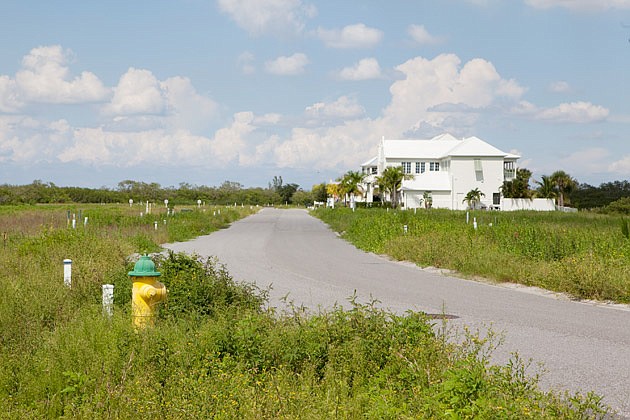Of the 233 community development districts along the Gulf Coast, 42 are already in default on $1.1 billion in debt to bondholders. That number could double in coming months.
Each of the Gulf Coast's eight counties has at least one community development district in default on bonds issued to pay for infrastructure and maintenance improvements.
Commonly known as CDDs, the districts are created under a state law to help pay for roads, drainage and parks infrastructure within new neighborhoods. The districts issue tax-exempt municipal bonds to finance the projects and then charge homeowners assessments to pay off the bond debts.
This has helped get projects going when local governments could not, or would not, commit funding for infrastructure.
When homes aren't selling, assessments don't get paid. The developer who issued the bonds must pay the debt, or as often happens, choose to walk away just as many homeowners have done when they owe more on their mortgage than the property is worth.
Banks with first mortgages and land loans are getting caught in the middle with no good exit strategy, mostly because they're second in line to bondholders' claims.
“That is a major problem for the banks. The builders have got their money out of the bank loans for the land,” says Richard Lehmann, president of Investor Securities Advisor, Inc. ISA maintains a comprehensive database of more than 3,000 municipal bond defaults that have taken place since 1980.
The best some banks can do is file wishful lawsuits to try to gain leverage to renegotiate with multiple parties and restructure the debt. Lehmann says that with the drop in land values, “banks are walking away because there's just no equity.” That means more big write-offs may be in the offing at an already difficult time when many commercial loans are also in trouble.
Better capitalized banks may be in a better position to protect their loans by paying the assessments, says economist Hank Fishkind, principal of Orlando-based Fishkind and Associates. Fishkind, whose firm helped create 70
CDDs, notes that Bank of America has done so when they see value in the real estate.
But they may be the exception, and according to CDD debt workout specialist Dan Carter of ITG Holdings, LLC in Naples, BofA has yet to step up to protect their position on a defaulted district in Lee County.
Large mutual fund institutions like Oppenheimer, Goldman Sachs, Nuveen and Alliance Bernstein typically have controlling interests in the bonds — bonds that, in some cases, may only be worth 50 cents on the dollar or less.
But now the big institutional bondholders call the shots.
In some cases, with the land as the collateral, they're becoming de facto speculative real estate investment funds, but also attracting lawsuits for exceeding maximum percentages for these types of investments within their funds, according to Lehmann.
Currently, there are 42 CDDs now in default in the region and another 46 on a “watch list” kept by Income Securities Advisor (ISA) publisher of the Distressed Debt Securities Newsletter, a new publication that is just one more sign of the times. Carter, who works closely with ISA, says, “I've never seen so much opportunity as far as workouts of problem deals.”
Those in default are mostly those set-up in the boom years from 2003 to 2007. Defaults add up to $1.14 billion, one-third of the $3.4 billion in default by 109 districts statewide. And that's up from $2.5 billion at the end of June after rising 260% from the first quarter.
Another $1.16 billion of Gulf Coast CDDs are on ISA's watch list that has grown from just 51 last month to 98 this month. CDDs on the watch list are projects started in 2007 or 2008 that have not completed the build-out phase of the infrastructure, and few, if any, new homes are being constructed.
“There's nothing fundamentally wrong with (the law),” says James Nicholas, an economist and professor emeritus at the University of Florida college of law who assisted in drafting the law. It's the economy.
Little Harbor, big default
Nicholas gets no argument from Bill Rizzetta, president of Rizzetta and Co. in Tampa with offices in Wesley Chapel, Fort Myers and three other Florida cities. Rizzetta provides advisory and management services for more than 130 CDDs and has been involved in more than 240 bond transactions adding up to $3.2 billion.
“It's a good law from a standpoint of public-private partnerships,” he says. “It's an alternative financing mechanism to build public infrastructure. When done correctly, it's a good mechanism.”
Rizzetta has been on the frontlines of the CDD world. Hillsborough County is home to 51 of them, second only to Miami-Dade County which has 52. In fact, the Gulf Coast can claim five of the top seven counties for CDDs: Lee County ranks third with 37; Pasco is next with 33, Manatee has 23 and Collier 21.
Unfortunately for Hillsborough, having that number of CDDs also makes the county the biggest for defaults in the region with $334.3 million, plus another $379 million on the watch list.
A total of 13 projects are currently in default in Hillsborough and 15 are on the watch list. Rizzetta has been involved with 20, including nine that have defaulted. But as an engineer with an MBA, he's a mercenary under the command of CDDs created by developers following state laws and with the approval of local governments.
If there's a fall guy, it's the economy and local governments that opted not to plan for growth and charged developers more than their fair share. It's no coincidence that CDDs are concentrated in high growth areas of faster growing states.
CDDs allow developers to finance the heavy upfront infrastructure costs and even finance impact fees, but its become a big expense for homeowners. State concurrency rules led to costly infrastructure standards adopted by local government.
High standards inflated development costs and pushed development away from urban areas where traffic standards could more easily be met. Most of Hillsborough's CDDs are clustered in the more rural southeastern part of the county.
The 368-acre South Bay Community Development District is the legal name for what is more commonly known today as Little Harbor Resort and Club in southern Hillsborough. It's located at the mouth of the Little Manatee River on Tampa Bay south of Apollo Beach.
Partially completed, the mixed-use project built around a marina, is in default of $98.7 million in bonds issued in 2005.
At least five banks, and builder McGeehan Construction, Inc. of Clearwater, who performed site work, are lining up with foreclosure lawsuits against the developer, EarthMark Companies of Fort Myers. The banks loaned about another $100 million. A call to the company was not returned.
Banks with the biggest loans outstanding include Peninsula Bank ($16.7 million), AmTrust Bank ($16 million), Orion Bank ($11.8 million) and Miami Lakes-based Great Florida Bank ($25 million).
In Lee County, the Arborwood CDD defaulted on $130.6 million in bonds, accounting for over half the default volume in the county. Similarly, in Collier County, two Fiddler's Creek developments total $135 million in defaults, nearly 60% of the county's total to date.
But looming on the combined Lee-Collier watch list is another $493 million of potential future defaults.
'tip of the iceberg'
Perhaps the biggest one to keep an eye on will be The Quarry CDD in east Collier, with $219.2 million in bonds.
The average unit comes with more than $100,000 in debt, and the 105 90-foot lots are looking at assessments totaling $243,356 per unit according to the October 2004 assessment methodology prepared by Fishkind and Associates.
“I don't know who's going to buy a home in there that has additional tax debt on it,” says ITG's Carter. And Carter thinks the taint that comes with problem districts will lead to more developer and district bankruptcies. “It wouldn't be the first time that a municipality actually filed bankruptcy,” he says.
The high debt-per-unit problem has apparently come to the attention of others. Russ Weyer, who handles CDD work for Fishkind out of their Naples office, says the district's new builder — Pulte Homes — just bought back some bonds (Carter estimates only about 5% of the bonds) at a discount to reduce the debt load and lower the assessments on some of the bonds.
It's a doubling down strategy while defaults may be doubling up. More such speculation in CDD bonds by may be on the horizon if bond prices continue to trend lower.
But there's also a school of thought amongst some experts that big institutional bondholders like Oppenheimer will decide they don't want to be a speculative subdivision fund by owning the projects. Should they choose to sell too many in too short a time period, bond prices would be further depressed. So, if companies like Pulte act too soon they could end up with more financial problems as the value of those bonds decline further.
On the other hand, if the controlling bondholders — be they fund managers or developers — can behave like long term investors, effectively they can pay themselves with future assessment proceeds as houses begin to sell again.
That may take the patience of Job, but offers a chance to make up what they lose on the bonds with property appreciation.
In the meantime, banks could restructure CDD debt. But the big bondholders hold the cards, and according to Lehmann are the only ones who can afford to restructure the debt.
Carter says he believes Fishkind agrees with him “that we're at the tip of iceberg on this stuff.” Another bigger round of defaults is expected next May when principal payments are also due. Carter has witnessed past problems with
CDDs, and from what he's observed says, “It's going to get a lot messier before it's over. It may be 20-30 years.”
The best way to avoid that, according to Carter, is to restructure the deals. But “so far banks are really hindering the situation,” he says, noting bondholders don't want to take a cut. “It's hard to get everyone on the same page.”
Key points about CDDS
• District bonds are fixed rate, tax-exempt revenue bonds sold to institutional buyers.
• Special assessment lien has priority over mortgage loan or any other liens.
• Special assessments run with the land and can be transferred to future property owners.
• Debt service on the bonds are payable only from the special assessments.






